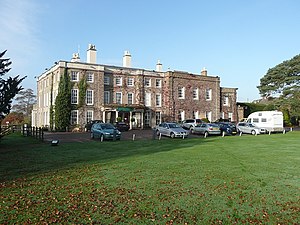Wychnor Hall
| Wychnor Park | |
|---|---|

Wychnor Park
|
|
| General information | |
| Town or city | Staffordshire |
| Country | England, United Kingdom |
| Coordinates | 52°44′53″N 1°45′38″W / 52.74806°N 1.76056°W |
| Client | The Levett Family |
Wychnor Hall (or Wychnor Park) is Grade II Listed early 18th-century country house near Burton on Trent, Staffordshire. The Hall was formerly owned by the Levett Family, descendants of Theophilus Levett, who was Steward of the city of Lichfield in the early eighteenth century.
The hall has been converted to a Country Club.
Wychnor takes its name from the Old English meaning 'village on a bank.' It's earliest spelling was H.wiccenofre. Ofre was the Anglo-Saxon word for "edge or bank". Hwicce was a provence comprising Gloucestershire, Worcestershire and a part of Warwickshire and the people were called Hwiccas or Hwicii. It is thought that some of these people came to settle in Wychnor and so gave their name to the place they settled in.
King James I reportedly stayed at the hall in 1621 and 1624.
The present hall dates from the time of Queen Anne but was much altered and extended in the mid 19th century.
There are a number of curious customs associated with Wychnor, at least one of which was said to have begun with Sir Philip de Somerville, who owned the manor of Wychnor in 1338. A flitch of bacon was kept in the hall that could be claimed by anyone who had been married "for a year and a day without quarrelling or repenting; and that if they were then single, and wished to be married again, the demandant would take the same party before any other in the world." Valid claimants being few and far between, the flitch was replaced by a wooden effigy of same, which continued to hang in the hall for many centuries.
The house was for many years the home of the Levett family (relations of Levett of Milford Hall). The family came from Sussex, arriving in Staffordshire from Cheshire in the early eighteenth century.
The family's wealth largely derived from ownership of coal mines in Staffordshire and Derbyshire, as well as large landholdings and investments in the early Industrial Revolution enterprises associated with inventor Matthew Boulton.
...
Wikipedia

